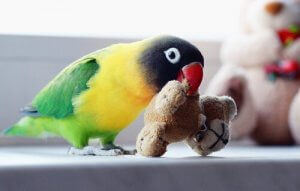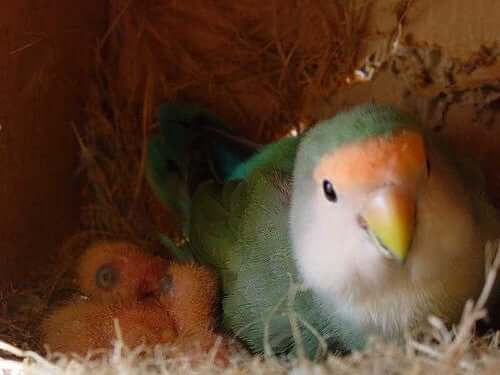What's It Like to Live With a Lovebird?

Did you know that lovebirds are gaining popularity as pets? There are more and more people getting them. They are very easy to care for, and these little critters have a very funny and friendly personality. Would you like to know what it’s like to live with a lovebird?
You might not have heard of lovebirds before or maybe you’ve never seen one. Let’s find out first what they are. After that, you’ll be able to read some handy tips on how to take care of lovebirds if you’d like one as a pet.
What’s a lovebird?
Lovebirds are colorful parrots that have a similar appearance to parakeets. Their official name, Agapornis, comes from a combination of two Greek words, “agape” (love), and “ornis” (bird).
Their name comes from the fact that lovebirds mate for life. The male and female birds spend a lot of time together and affectionately preen each other’s feathers.

These birds are quite small in size. They range between 5 and 6 1/2 inches long. Lovebirds eat fruit, seeds and shoots, and normally live for about 10 to 15 years.
What it’s like to live with a lovebird
Surprisingly, a lovebird will come if you call it. They like to snuggle up to their owner, just be around you, and they love to play. When a lovebird gets used to you, it might affectionately start to rub your head, nibble your hair or earlobe, or snuggle against your neck.
Lovebirds are somewhat different from other pets, but having one won’t be any less enjoyable. Once your new bird is happy and established in your home, it won’t try to escape even if you leave the windows open.
They are very loyal animals and like to have a family and live with people.
Lovebirds are great to have at home as pets, even though, of course, they’re not as common as dogs or cats. It would be ideal to have as a pet in a household with kids, and will play around and do funny things that will make your kids (and everyone else in your house) smile.
How to take care of a lovebird
It’s pretty easy and straightforward to know how to take care of more traditional pets like dogs or cats, due to your own experience or even just the wealth of information you can find on the internet.
However, with lovebirds it can be a little different, since they aren’t very common pets. Even though they are becoming more popular as pets in many homes, there isn’t that much information available on how to take care of them.

Here are some handy tips to help you live with a lovebird
- Let it fly. These birds must have exercise. With that in mind, you should let it fly around your house freely; that way it’ll be able to stay in shape. What if you’re worried that it might escape (if it’s still pretty new in your house)? Well, before you let it out, close the doors and windows. Whichever way you want to do it, you should let it out for a fly around each day.
- Feeding. These little creatures need a lot of different minerals and vitamins, and very little fat. You can give it some fruit and vegetables, but don’t forget to give it a mixture of grains and seeds specifically for lovebirds. You can find these seed mixes in specialty pet shops.
- Sun. This is essential for all birds, including lovebirds. They need direct sunlight, without filters. That means that you should give your bird access to the sun by putting it next to the window or even outside for several hours each day.
- Give it a mate. Although lovebirds can live on their own, they will feel lonely. Lovebirds are made for living in twos, so if you want yours to be happy, give it a mate. If one of the birds dies, look for a substitute.
- Take it to the vet. Birds are good at hiding when they’re sick. Regular visits to the vet are essential for quickly diagnosing any health problems.
All you need is….a lovebird
So, what do you think? The fact is that lovebirds would make a very special and unique pet. Would you like to live with a lovebird? We can guarantee it’ll be very rewarding, and with these handy tips on how to take care of them, it’ll be a breeze. Put a little lovebird in your life!
Did you know that lovebirds are gaining popularity as pets? There are more and more people getting them. They are very easy to care for, and these little critters have a very funny and friendly personality. Would you like to know what it’s like to live with a lovebird?
You might not have heard of lovebirds before or maybe you’ve never seen one. Let’s find out first what they are. After that, you’ll be able to read some handy tips on how to take care of lovebirds if you’d like one as a pet.
What’s a lovebird?
Lovebirds are colorful parrots that have a similar appearance to parakeets. Their official name, Agapornis, comes from a combination of two Greek words, “agape” (love), and “ornis” (bird).
Their name comes from the fact that lovebirds mate for life. The male and female birds spend a lot of time together and affectionately preen each other’s feathers.

These birds are quite small in size. They range between 5 and 6 1/2 inches long. Lovebirds eat fruit, seeds and shoots, and normally live for about 10 to 15 years.
What it’s like to live with a lovebird
Surprisingly, a lovebird will come if you call it. They like to snuggle up to their owner, just be around you, and they love to play. When a lovebird gets used to you, it might affectionately start to rub your head, nibble your hair or earlobe, or snuggle against your neck.
Lovebirds are somewhat different from other pets, but having one won’t be any less enjoyable. Once your new bird is happy and established in your home, it won’t try to escape even if you leave the windows open.
They are very loyal animals and like to have a family and live with people.
Lovebirds are great to have at home as pets, even though, of course, they’re not as common as dogs or cats. It would be ideal to have as a pet in a household with kids, and will play around and do funny things that will make your kids (and everyone else in your house) smile.
How to take care of a lovebird
It’s pretty easy and straightforward to know how to take care of more traditional pets like dogs or cats, due to your own experience or even just the wealth of information you can find on the internet.
However, with lovebirds it can be a little different, since they aren’t very common pets. Even though they are becoming more popular as pets in many homes, there isn’t that much information available on how to take care of them.

Here are some handy tips to help you live with a lovebird
- Let it fly. These birds must have exercise. With that in mind, you should let it fly around your house freely; that way it’ll be able to stay in shape. What if you’re worried that it might escape (if it’s still pretty new in your house)? Well, before you let it out, close the doors and windows. Whichever way you want to do it, you should let it out for a fly around each day.
- Feeding. These little creatures need a lot of different minerals and vitamins, and very little fat. You can give it some fruit and vegetables, but don’t forget to give it a mixture of grains and seeds specifically for lovebirds. You can find these seed mixes in specialty pet shops.
- Sun. This is essential for all birds, including lovebirds. They need direct sunlight, without filters. That means that you should give your bird access to the sun by putting it next to the window or even outside for several hours each day.
- Give it a mate. Although lovebirds can live on their own, they will feel lonely. Lovebirds are made for living in twos, so if you want yours to be happy, give it a mate. If one of the birds dies, look for a substitute.
- Take it to the vet. Birds are good at hiding when they’re sick. Regular visits to the vet are essential for quickly diagnosing any health problems.
All you need is….a lovebird
So, what do you think? The fact is that lovebirds would make a very special and unique pet. Would you like to live with a lovebird? We can guarantee it’ll be very rewarding, and with these handy tips on how to take care of them, it’ll be a breeze. Put a little lovebird in your life!
This text is provided for informational purposes only and does not replace consultation with a professional. If in doubt, consult your specialist.








